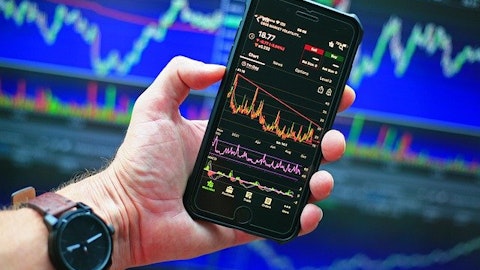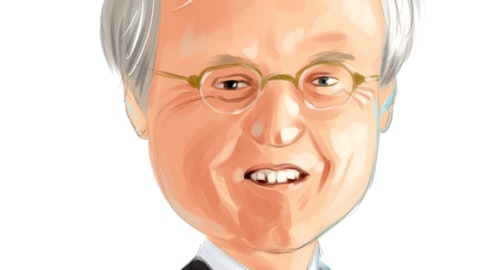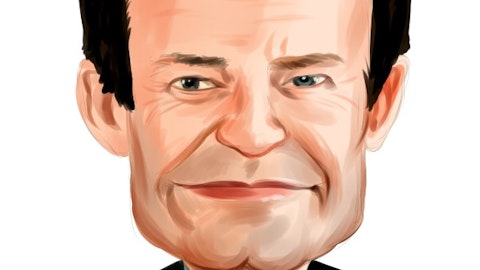In this article, we discuss 5 dividend aristocrats with over 3% yield. If you want our detailed analysis of these stocks, go directly to 10 Dividend Aristocrats with Over 3% Yield.
5. Cardinal Health, Inc. (NYSE:CAH)
Dividend Yield as of January 25: 3.94%
Number of Hedge Fund Holders: 36
Number of Years of Consecutive Dividend Increases: 34
Cardinal Health, Inc. (NYSE:CAH) is an American multinational healthcare company that distributes pharmaceutical, medical, and surgical products. Cardinal Health, Inc. (NYSE:CAH) offers its products to a majority of the United States hospitals.
On November 4, Cardinal Health, Inc. (NYSE:CAH) declared a $0.4908 per share quarterly dividend, in line with previous. The dividend was paid on January 15, to shareholders of record on January 3.
Barclays analyst Steve Valiquette lowered the price target on Cardinal Health, Inc. (NYSE:CAH) to $63 from $65 and kept an Overweight rating on the shares on January 11. The analyst remains positive on the healthcare distribution subsector in 2022 given the upside potential from generic/biosimilar pipelines, additional anticipated COVID-19 tailwinds, and waning risks from other variables previously perceived as overhangs, such as generic pricing volatility and opioid litigation.
Among the hedge funds tracked by Insider Monkey in Q3 2021, Pzena Investment Management is the leading Cardinal Health, Inc. (NYSE:CAH) stakeholder, with a $146.2 million position. Overall, 36 hedge funds were long Cardinal Health, Inc. (NYSE:CAH) in the third quarter of 2021.
4. Chevron Corporation (NYSE:CVX)
Dividend Yield as of January 25: 4.07%
Number of Hedge Fund Holders: 51
Number of Years of Consecutive Dividend Increases: 34
Chevron Corporation (NYSE:CVX) has consistently increased its dividend payouts for 34 years. Chevron Corporation (NYSE:CVX) is a California-based multinational energy corporation that supplies gasoline, natural gas, oil, and other petrochemicals.
On October 27, Chevron Corporation (NYSE:CVX) declared a $1.34 per share quarterly dividend, in line with previous. The dividend was paid on December 10, to shareholders of record on November 18.
Truist analyst Neal Dingmann on January 14 kept a Buy rating on Chevron Corporation (NYSE:CVX), elevating the price target to $167 from $150. The analyst noted that oil-weighted exploration and production names warrant higher price targets as he increased his 2022 oil price estimates by approximately 10% and 2023 estimates by roughly 8%.
Ric Dillon’s Diamond Hill Capital is the leading stakeholder of Chevron Corporation (NYSE:CVX), owning 5.1 million shares worth $523.8 million. The Q3 data of Insider Monkey reported that 51 hedge funds were bullish on Chevron Corporation (NYSE:CVX), with stakes equaling $4.4 billion.
Here is what Goehring & Rozencwajg Associates has to say about Chevron Corporation (NYSE:CVX) in its Q3 2021 investor letter:
“After successfully replacing 25% of Exxon’s board of directors despite owning just 0.02% of the outstanding equity, Engine No. 1, the climate-focused activist hedge fund, met with Chevron’s management late last summer. In discussions that were later described as “cordial,” Chevron executives shared their plan to reduce carbon emissions. Subsequently, Chevron announced new plans to further reduce carbon output, along with their intention to appoint a new director with “environmental expertise.” Although it remains unclear exactly what Engine No. 1 is planning, rumors suggest the fund has contacted other investors, strongly suggesting they intend to launch a second campaign in the not-too-distant future.
What should Chevron expect?
It was recently reported by The Wall Street Journal that Exxon was considering abandoning two massive natural gas projects: the 75 trillion cubic foot (tcf ) Rovuma LNG project (capital cost $30 bn) and the 5 tcf Ca Voi Xanh offshore-Vietnam gas project (capital cost $10 bn). Exxon board members (most likely including the three supported by Engine No. 1) have publicly expressed concerns about both projects. According to internal reports, these projects are among the highest CO2 producers in Exxon’s pipeline; it is no surprise these projects have been called into question. However, we find the plight of both fields to be perplexing since production would almost certainly be used to displace coal in electricity generation, cutting CO2 emissions by nearly 50%. This fact seems to be lost on the new Exxon board members.”
3. Leggett & Platt, Incorporated (NYSE:LEG)
Dividend Yield as of January 25: 4.14%
Number of Hedge Fund Holders: 16
Number of Years of Consecutive Dividend Increases: 50
Leggett & Platt, Incorporated (NYSE:LEG) is a Missouri-based maker of bedding, furniture, flooring, and textiles, supplying its products to retailers, department stores, and home improvement brands. According to Insider Monkey’s Q3 database, 16 hedge funds were bullish on Leggett & Platt, Incorporated (NYSE:LEG), with stakes totaling $56.1 million.
Leggett & Platt, Incorporated (NYSE:LEG) declared on November 9 a $0.42 per share quarterly dividend, which is a 5% increase from its prior dividend of $0.40, paid on January 14, to shareholders of record on December 15. Leggett & Platt, Incorporated (NYSE:LEG) has elevated its dividends for 50 years consecutively, and the stock offers a 4.14% yield as of January 25.
Balyasny Asset Management is the largest Leggett & Platt, Incorporated (NYSE:LEG) shareholder, with a $10.3 million position in the company as of Q3.
2. Exxon Mobil Corporation (NYSE:XOM)
Dividend Yield as of January 25: 4.69%
Number of Hedge Fund Holders: 64
Number of Years of Consecutive Dividend Increases: 39
An American multinational oil and gas company, Exxon Mobil Corporation (NYSE:XOM) is a notable descendant of Rockefeller’s Standard Oil. Headquartered in Irving, Texas, Exxon Mobil Corporation (NYSE:XOM) specializes in crude oil, oil products, natural gas, petrochemicals, and power generation. Exxon Mobil Corporation (NYSE:XOM) announced its ambition for net zero greenhouse gas emissions by 2050 on January 18.
On October 27, Exxon Mobil Corporation (NYSE:XOM) declared a $0.88 per share quarterly dividend, which is a 1.1% increase from its prior dividend of $0.87. The dividend was distributed on December 10, to shareholders of record on November 12.
Offering a dividend yield of 4.59% as of January 25, Exxon Mobil Corporation (NYSE:XOM) has consecutively raised its dividends for 39 years, making it a notable dividend aristocrat to invest in.
RBC Capital analyst Biraj Borkhataria on January 19 upgraded Exxon Mobil Corporation (NYSE:XOM) to Sector Perform from Underperform with a price target of $90, up from $70. The analyst has been concerned with Exxon Mobil Corporation (NYSE:XOM)’s position in the investment cycle relative to its peers, but now he believes that the overall tailwinds for the sector are likely to outweigh company specific factors in 2022.
GQG Partners is the largest Exxon Mobil Corporation (NYSE:XOM) stakeholder, with 26.5 million shares worth $1.56 billion. In the third quarter of 2021, 64 hedge funds tracked by Insider Monkey were bullish on Exxon Mobil Corporation (NYSE:XOM), down from 68 funds in the preceding quarter.
Here is what First Eagle Investment Management has to say about Exxon Mobil Corporation (NYSE:XOM) in its Q2 2021 investor letter:
“Leading contributors in the First Eagle Global Fund this quarter included Exxon Mobil Corporation. The continued recovery in oil prices as economies reopen helped fuel another strong performance across the energy complex, including shares of Exxon Mobil. Exxon Mobil recently lost a proxy fight with an activist investor that took three of the company’s 12 board seats. While the press was focused on the investor’s concerns over Exxon Mobil’s long term energy transformation strategy, other factors fundamental to shareholder returns—like capital discipline and balance sheet management—were also at play.”
1. International Business Machines Corporation (NYSE:IBM)
Dividend Yield as of January 25: 4.80%
Number of Hedge Fund Holders: 41
Number of Years of Consecutive Dividend Increases: 26
International Business Machines Corporation (NYSE:IBM), a multinational technology corporation, is one of the most notable dividend aristocrats. International Business Machines Corporation (NYSE:IBM) has boosted its dividend payouts consecutively for 26 years.
On October 26, International Business Machines Corporation (NYSE:IBM) declared a $1.64 per share quarterly dividend, in line with previous, which was paid on December 10.
Evercore ISI analyst Amit Daryanani on January 25 said that International Business Machines Corporation (NYSE:IBM) reported “impressive” December quarter revenue and EPS that beat Street consensus, highlighted by about 5% growth in constant currency across both consulting and software. The analyst kept an In Line rating and a $140 price target on the International Business Machines Corporation (NYSE:IBM) stock.
Among the hedge funds tracked by Insider Monkey in Q3 2021, 41 funds reported owning stakes in International Business Machines Corporation (NYSE:IBM), equaling $1.40 billion. Arrowstreet Capital is one of the largest International Business Machines Corporation (NYSE:IBM) stakeholders, with 2.8 million shares worth $398.1 million.
Here is what St. James Investment Company has to say about International Business Machines Corporation (NYSE:IBM) in its Q4 2021 investor letter:
“IBM was not the first company to build computers. The distinction belongs to Sperry-Rand’s subsidiary UNIVAC, which introduced the first commercially successful computers in the early 1950s. In this era, IBM did possess the largest research and development department of the business machines industry and quickly caught up, introducing cost-competitive computers a few years after UNIVAC. By the late 1950s, IBM held the dominant market share in computers. IBM also touted a vastly superior sales organization, which used a sales tactic called “paper machines” (the equivalent of today’s “vaporware”). If a competitor’s product was selling well in a market segment that IBM had yet to penetrate, the company would announce a competing product and start taking orders for the “paper machine” long before it was available.
One cannot overstate how powerful IBM was in the computer industry in the 1950s and 1960s. Every competitor rightly worried that if their product worked too well for too long, it was only a matter of
time before an army of IBM salesforce representatives mobilized. In their easily recognizable uniforms of starched white shirts, red ties and blue suits, IBM marketers marched on their customers and offered a more expensive, but much more defensible, choice. “Nobody gets fired for buying IBM” was a common phrase. Even competitors acknowledged that the company excelled at sales. As a UNIVAC executive once complained, ‘It doesn’t do much good to build a better mousetrap if the other guy selling mousetraps has five times as many salesmen.’” (Click here to see the full text)
You can also take a look at 9 Stocks That Credit Markets Expert Steve Ketchum Likes and 10 Stocks to Sell According to Billionaire Daniel Sundheim.





